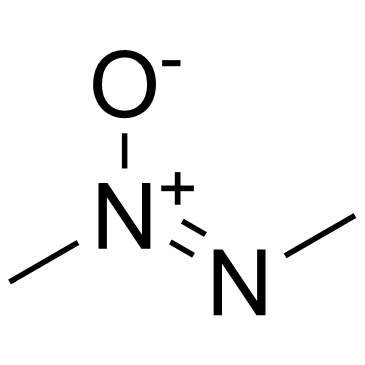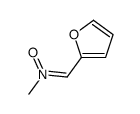Azoxymethane

Azoxymethane structure
|
Common Name | Azoxymethane | ||
|---|---|---|---|---|
| CAS Number | 25843-45-2 | Molecular Weight | 74.08180 | |
| Density | 0.98g/cm3 | Boiling Point | 92ºC at 760mmHg | |
| Molecular Formula | C2H6N2O | Melting Point | N/A | |
| MSDS | Chinese USA | Flash Point | 9.4ºC | |
| Symbol |



GHS02, GHS06, GHS08 |
Signal Word | Danger | |
Use of AzoxymethaneAzoxymethane is a colon carcinogen which leads to the formation of DNA adducts. |
| Name | Azoxymethane |
|---|---|
| Synonym | More Synonyms |
| Description | Azoxymethane is a colon carcinogen which leads to the formation of DNA adducts. |
|---|---|
| Related Catalog | |
| In Vitro | Azoxymethane is a colon carcinogen which leads to the formation of DNA adducts. On an equal protein basis, hepatic microsomes are much more active than SI and colon microsomes in NADPH-dependent Azoxymethane bioactivation and N7-mG adduct formation. Hepatic microsomes show the highest activity in the hydroxylation of Azoxymethane, followed by SI and colon microsomes[1]. |
| In Vivo | Regardless of the strain, the amounts of O6-mG and N7-mG produced by Azoxymethane are highest in the liver, followed by proximal and distal colons, which have similar levels, and then by duodenum, jejunum and ileum. Results indicate that the Azoxymethane-induced DNA adduct formation in the SI and colon does not depend on bioactivation by hepatic P450 enzymes. Irrespective of the mouse strain, no aberrant crypt foci (ACF) is detected in the colons of saline-treated mice; in contrast, colonic ACF is detected in all three strains of Azoxymethane-treated mice[1]. The Azoxymethane-treated athymic mice have approximately an 11-fold lower tumor incidence than similarly treated WT animals[2]. |
| Kinase Assay | The assay for Azoxymethane-induced in vitro DNA adduct formation is performed. Briefly, microsomes (0.5 to 2.0 mg/mL) are incubated with calf thymus DNA (1 mg/mL) and Azoxymethane (200 μM) in a total volume of 1.0 mL. The assay buffer consists of 0.1 M Tris-HCl (pH 7.4), 1 mM EDTA, 20 mM MgCl2, 0.3 M KCl, and 1.5 mM NADPH. Incubations are carried out at 37°C for 60 min in a shaking water bath. An additional 30 nM of NADPH is added after the first 30 min. The reaction is stopped by the addition of 0.5 mL of ice-cold 7.5 M ammonium acetate. DNA is then extracted for tissue homogenates. Control incubations are performed without NADPH[1]. |
| Animal Admin | Male, 8 to 10 week old, WT-A/J, IECN-A/J, and LCN-A/J mice (8 per group) are treated with either saline or Azoxymethane (7.5 mg/kg BW, s.c.), once weekly for 3 weeks. Mice are sacrificed 6 weeks post-treatment for aberrant crypt foci (ACF) detection. The entire colon is excised. A longitudinal incision is made along the entire length of the colon, which is further cut into two equal-length segments, representing proximal and distal portions of the colon. The segments are dipped in PBS to remove fecal pellets and then kept flat between filter papers in 10% buffered formalin for at least 24 h. Subsequently, the colons are immersed in freshly prepared 0.1% methylene blue for 10 min and rinsed briefly in deionized H2O to remove excess dye. The colon is mounted carefully on a microscope slide with the mucosal surface side up and viewed under a light microscope. The ACF in the entire mucosal surface of the colon are counted blindly and independently by two investigators and recorded[1]. |
| References |
| Density | 0.98g/cm3 |
|---|---|
| Boiling Point | 92ºC at 760mmHg |
| Molecular Formula | C2H6N2O |
| Molecular Weight | 74.08180 |
| Flash Point | 9.4ºC |
| Exact Mass | 74.04800 |
| PSA | 41.11000 |
| LogP | 0.73170 |
| Vapour Pressure | 59.7mmHg at 25°C |
| Index of Refraction | 1.427 |
CHEMICAL IDENTIFICATION
HEALTH HAZARD DATAACUTE TOXICITY DATA
MUTATION DATA
|
| Symbol |



GHS02, GHS06, GHS08 |
|---|---|
| Signal Word | Danger |
| Hazard Statements | H226-H300-H315-H319-H350 |
| Precautionary Statements | P201-P210-P280-P301 + P310 + P330-P308 + P313-P337 + P313 |
| Hazard Codes | T: Toxic; |
| Risk Phrases | 45-46-10-25-34 |
| Safety Phrases | S26;S45;S53;S36/S37/S39 |
| RIDADR | UN 1992 3/PG 3 |
| RTECS | PA2975000 |
| HS Code | 2927000090 |
|
~% 
Azoxymethane CAS#:25843-45-2 |
| Literature: Canadian Journal of Chemistry, , vol. 59, p. 264 - 268 |
|
~% 
Azoxymethane CAS#:25843-45-2 |
| Literature: Indian Journal of Chemistry, Section B: Organic Chemistry Including Medicinal Chemistry, , vol. 23, # 8 p. 758 |
|
~% 
Azoxymethane CAS#:25843-45-2 |
| Literature: Indian Journal of Chemistry, Section B: Organic Chemistry Including Medicinal Chemistry, , vol. 23, # 8 p. 758 |
| HS Code | 2927000090 |
|---|---|
| Summary | 2927000090 other diazo-, azo- or azoxy-compounds。Supervision conditions:None。VAT:17.0%。Tax rebate rate:9.0%。MFN tariff:6.5%。General tariff:30.0% |
|
Loss of Stromal IMP1 Promotes a Tumorigenic Microenvironment in the Colon.
Mol. Cancer Res. 13 , 1478-86, (2015) The colon tumor microenvironment is becoming increasingly recognized as a complex but central player in the development of many cancers. Previously, we identified an oncogenic role for the mRNA-bindin... |
|
|
The MUTYH base excision repair gene protects against inflammation-associated colorectal carcinogenesis.
Oncotarget 6 , 19671-84, (2015) MUTYH DNA glycosylase removes mismatched adenine opposite 7, 8-dihydro-8-oxoguanine (8-oxoG), which is the major mutagenic lesion induced by oxidative stress. Biallelic mutations in MUTYH are associat... |
|
|
15-Lipoxygenase-1 suppression of colitis-associated colon cancer through inhibition of the IL-6/STAT3 signaling pathway.
FASEB J. 29 , 2359-70, (2015) The IL-6/signal transducer and activator of transcription 3 (STAT3) pathway is a critical signaling pathway for colitis-associated colorectal cancer (CAC). Peroxisome proliferator-activated receptor (... |
| methyl-methylimino-oxidoazanium |
| MFCD00126912 |




![5,7-dimethyl-3-phenyl-[1,2]oxazolo[3,4-d]pyrimidine-4,6-dione structure](https://image.chemsrc.com/caspic/173/65183-49-5.png)

![3-Furan-2-yl-5,7-dimethyl-7H-isoxazolo[3,4-d]pyrimidine-4,6-dione structure](https://image.chemsrc.com/caspic/041/91166-65-3.png)